Excerpts from Jim Conrad's
Naturalist Newsletter
from the December 7, 2014 Newsletter issued from Río Lagartos, on the Yucatan Peninsula's northern coast (~N21.60°, ~W88.16°), Yucatán state, MÉXICO
SABUCÁN CACTUS
The most common cactus in the arid savanna just south of Río Lagartos is a sprawling pricklypear, or Opuntia cactus. However, the most striking is a less abundant but somewhat common columnar, weakly branched one that often rises from among broadleaf scrub, exactly as you can see in the picture below, with my photographer friend Jim Legault providing scale:
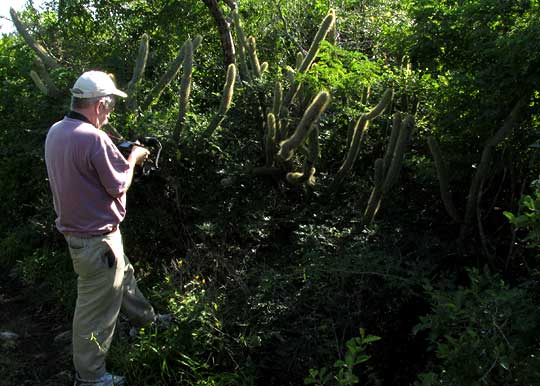
A shot better showing the cactus's typical form is seen below:
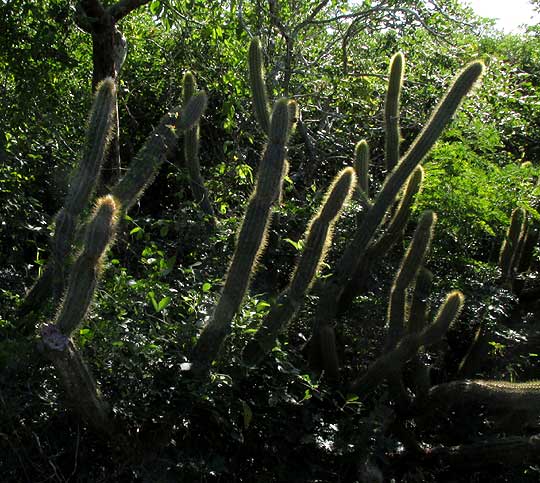
The cactus's pale, slender spines are arranged in clusters of about twenty pointing in all directions, sea-urchin-like. The clusters arise evenly spaced atop the stem's ridges, as shown below:
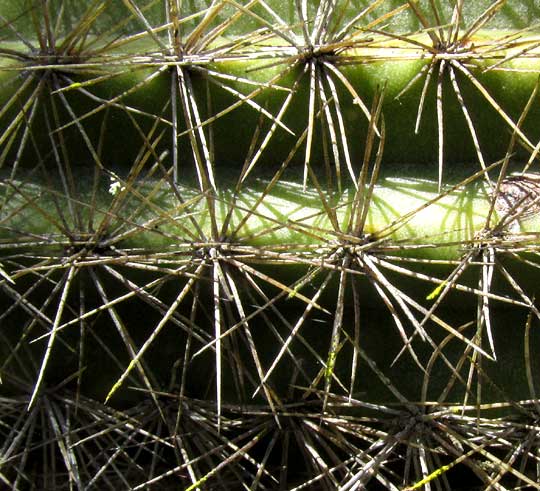
About a month ago I found one of these cacti with a flower bud about to open. You can see that below, plus notice how spine clusters at stem tops are woolly-white at their bases:
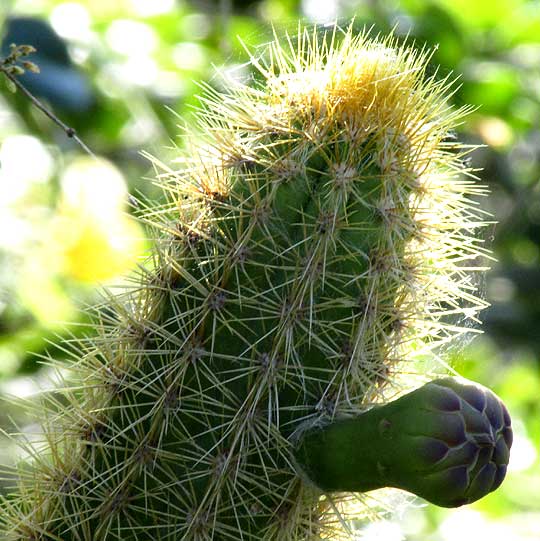
Twice I returned when I thought the flower might be open, but the cactus stood near a spot in the scrub where a fellow kept bee hives, and those bees were mean ones, apparently "Africanized" with genes from "killer bees" that a few years ago worked their way north from South America, and I was chased away. This week when I got back a month after the flower-bud picture was taken -- this time on a windy day when maybe the bees were less active -- the flower bud had developed into a green, immature fruit, with the corolla's dried-up, black remains dangling from the warty fruit's center, as seen below:
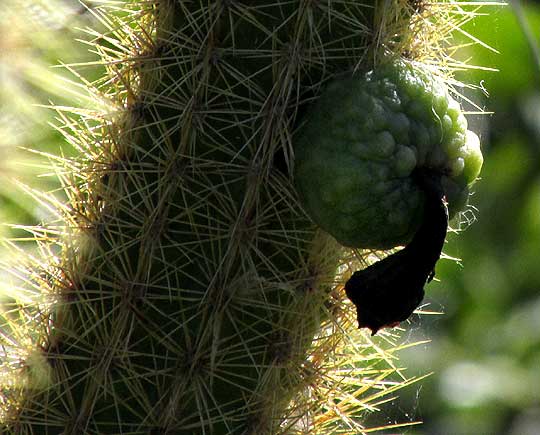
This is PILOSOCEREUS GAUMERI, endemic to just the northern Yucatan Peninsula. The species is so little known that it doesn't have a good English name, but its Spanish name is Sebucán. Some experts have regarded Sebucán as merely a variation of the more widely distributed Pilosocereus royenii, known as Royen's Tree Cactus and occurring throughout the Caribbean. However, now the general consensus appears to be that our Yucatan plants are indeed a separate species.
I missed the flower, but I hope to see the fruit at maturity, and maybe sample its contents, for the fruit is edible, filled with sweet, juicy, red pulp in which many seeds are embedded.
from the September 29, 2008 Newsletter written in Sabacché and issued from a ciber in nearby Tekit, in south-central Yucatán, MÉXICO
CACTUS WITH A WREN NEST
Out in the scrub, especially in rocky places chewed and stomped severely by cattle, there are two ubiquitous cactus species, which you can see below:
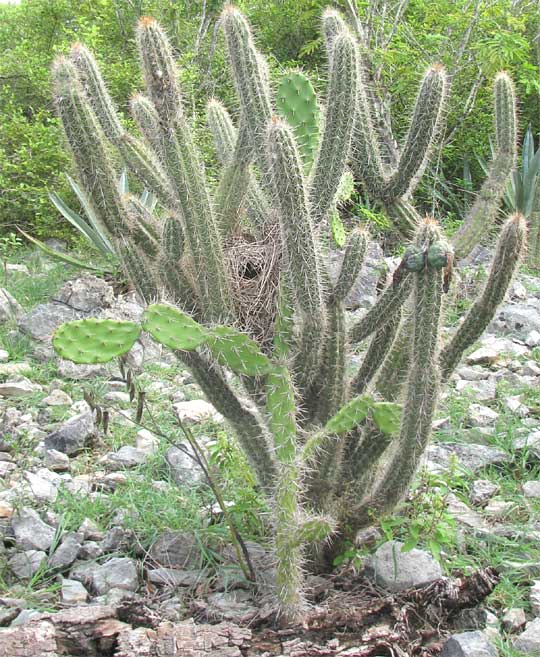
First of all, look for the wren nest, a ball of brown straw with a black entry hole approximately in the picture's center. Such covered nests with holes at the side or slanting downward are common out in the scrub.
The smaller, yellowish green, flat-jointed cactus up front, clearly one of the prickly-pears, I'm assuming to be OPUNTIA INAPERTA, sometimes called Nopalia gaumeri, notable for its slender, elongate pads. It's not flowering or fruiting now and here grows seven or more feet high.
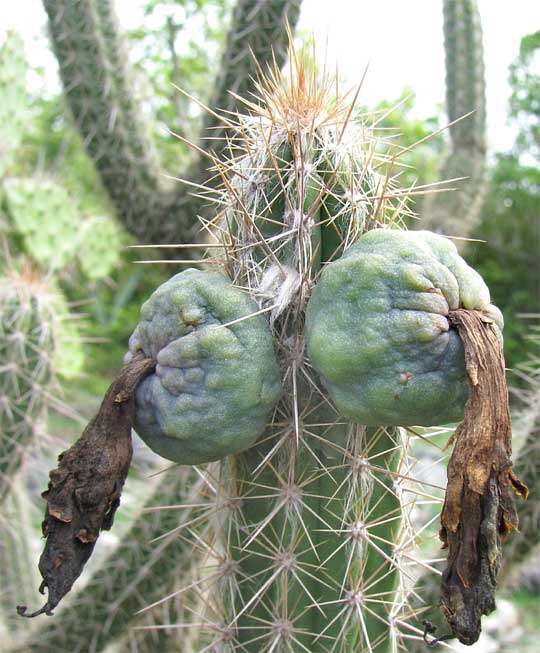
As shown above, this old-man cactus was fruiting. In that picture two somewhat flattened, spherical, or "depressed-globose," fruits, bear the limp, brown remains of the earlier flowers. Bearing the flower remains is typical for the species in the genus and I just wonder why. In this close-up you can also see tufts of white wool. On some joints the wool is much more conspicuous.
I suspect that both of these species are endemic to the Yucatán because I don't find them mentioned in my books, plus both have been named "gaumeri," which is the Latinized form of the name Gaumer. Upon finding Jatropha gaumeri and Mammillaria gaumeri during my 2006 stay in Río Lagartos on the Yucatán's northern coast, I wrote in my November 13th, 2006 Newsletter:
"George Franklin Gaumer (1850-1929) was a US citizen residing in the Yucatan from 1884 to his death, and he collected a remarkable number of rare and endemic species, which he sent to specialists for identification or, if they were unknown to science, for naming. Many of those specialists named the undescribed plants after their discoverer, Gaumer. There's Acacia gaumeri, Caesalpinia gaumeri, Thevetia gaumeri, Vitex gaumeri, and many more."
from the June 14, 2015 Newsletter issued from Río Lagartos, on the Yucatan Peninsula's northern coast (~N21.60°, ~W88.16°), Yucatán state, MÉXICO
SABUCÁN CACTUS FLOWERING
The Sabucán's flowers seldom are seen. Apparently they open only briefly, maybe only for one night, and until now I've been unable to catch one. However, one morning this week one was still open, as shown below:
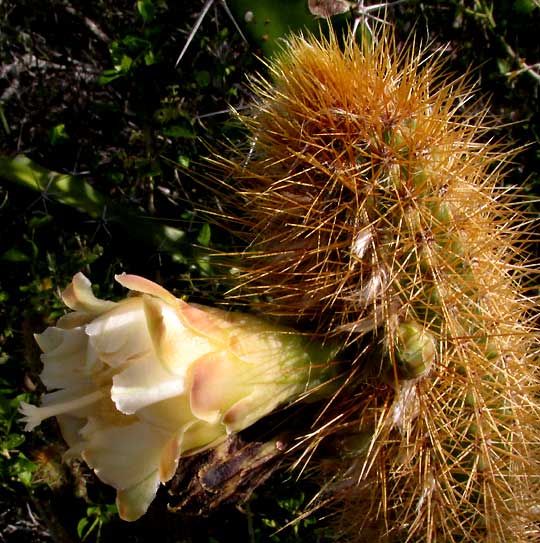
Even this flower appeared to be closing up in mid-morning.